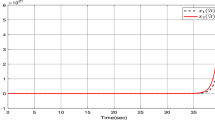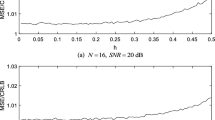Abstract
The sampling rate conversion is always used in order to decrease computational amount and storage load in a system. The fractional Fourier transform (FRFT) is a powerful tool for the analysis of nonstationary signals, especially, chirp-like signal. Thus, it has become an active area in the signal processing community, with many applications of radar, communication, electronic warfare, and information security. Therefore, it is necessary for us to generalize the theorem for Fourier domain analysis of decimation and interpolation. Firstly, this paper defines the digital frequency in the fractional Fourier domain (FRFD) through the sampling theorems with FRFT. Secondly, FRFD analysis of decimation and interpolation is proposed in this paper with digital frequency in FRFD followed by the studies of interpolation filter and decimation filter in FRFD. Using these results, FRFD analysis of the sampling rate conversion by a rational factor is illustrated. The noble identities of decimation and interpolation in FRFD are then deduced using previous results and the fractional convolution theorem. The proposed theorems in this study are the bases for the generalizations of the multirate signal processing in FRFD, which can advance the filter banks theorems in FRFD. Finally, the theorems introduced in this paper are validated by simulations.
Similar content being viewed by others
Abbreviations
- FT:
-
Fourier transform
- FD:
-
Fourier domain
- FRFT:
-
Fractional Fourier transform
- FRFD:
-
Fractional Fourier domain
- DTFRT:
-
Discrete-time FRFT
- F p [.]:
-
Notation for FRFT with order p
- X p (u):
-
Transform result of x(t) for FRFT with order p
- \(\tilde F_p [.]\) :
-
Notation for DTFRT with order p
- \(\tilde X_p [.]\) :
-
Transform result of x(t) for D TFRT with order p
- L,M:
-
The integer factor
References
Wiener N. Hermitian polynomials and Fourier analysis. J Math Phys MIT, 1929, 18: 70–73
Almeida L B. The fractional Fourier transform and time-frequency representations. IEEE Trans Sig Proc, 1994, 42(11): 3084–3091
Tao R, Qi L, Wang Y. Theory and Applications of the Fractional Fourier Transform (in Chinese). Beijing: Tsinghua University Press, 2004, 23–49
Tao R, Deng B, Wang Y. Research progress of the fractional Fourier transform in signal processing. Sci China Ser F-Inf Sci, 2006, 49(1): 1–25
Yetik I S, Nehorai A. Beamforming using the fractional Fourier transform. IEEE Trans Sig Proc, 2003, 51(6): 1663–1668
Djurovic I, Stankovic S, Pitas I. Digital watermarking in the fractional Fourier transformation domain. J Network Comp Appl, 2001, 24: 167–173
Martone M. A multicarrier system based on the fractional Fourier transform for time-frequency-selective channels. IEEE Trans Commun, 2001, 49(6): 1011–1020
Kutay M A, Ozaktas H M, Ankan O, et al. Optimal filtering in fractional Fourier domains. IEEE Trans Sig Proc, 1997, 45(5): 1129–1143
Qi L, Tao R, Zhou S Y, et al. Detection and parameter estimation of multi component LFM signal based on the fractional Fourier transform. Sci China Ser F-Inf Sci, 2004, 47(2): 184–198
Qi L, Tao R, Zhou S Y, et al. Frequency sweeping interference suppressing in DSSS system using fractional Fourier transform, Acta Electron Sin (in Chinese), 2004, 32(5): 799–802
Chen E Q, Tao R, Zhang W Q. A method for time-varying channel parameter estimation based on fractional Fourier transform. Acta Electron Sin (in Chinese), 2005, 33(12): 2101–2104
Zhao X H, Tao R. A new MTD algorithm for passive radar based on fractional correlation. Acta Electron Sin (in Chinese), 2005, 33(9): 1567–1570
Vaidyanathan P P. Multirate digital filters, filter banks, polyphase networks, and applications: a tutorial. Proc IEEE, 1990, 78(1): 56–93
Hu G S. Modern Signal Processing: A Tutorial (in Chinese). Beijing: Tsinghua University Press, 2004. 4–9, 121–132
Zhang W Q, Tao R. Sampling theorems for bandpass signals with fractional Fourier transform. Acta Electron Sin (in Chinese), 2005, 33(7): 1196–1199
Erseghe T, Kraniauskas P, Cariolaro G. Unified fractional Fourier transform and sampling theorem. IEEE Trans Sig Proc, 1999, 47(12): 3419–3423
Wang S Y. Digital Signal Processing: A Tutorial (in Chinese), Beijing: Beijing Institute of Technology Press, 2003. 40–43
Zayed A I. A convolution and product theorem for the fractional Fourier transform. IEEE Sig Proc Lett, 1998, 5(4): 101–103
Pei S C, Ding J J. Closed-form discrete fractional and affine Fourier transforms. IEEE Trans Sig Proc, 2000, 48(5): 1338–1353
Author information
Authors and Affiliations
Corresponding author
Additional information
Supported partially by the National Natural Science Foundation of China (Grant Nos. 60232010 and 60572094), and the National Natural Science Foundation of China for Distinguished Young Scholars (Grant No. 60625104)
Rights and permissions
About this article
Cite this article
Meng, X., Tao, R. & Wang, Y. Fractional Fourier domain analysis of decimation and interpolation. SCI CHINA SER F 50, 521–538 (2007). https://doi.org/10.1007/s11432-007-0040-7
Received:
Accepted:
Issue Date:
DOI: https://doi.org/10.1007/s11432-007-0040-7




